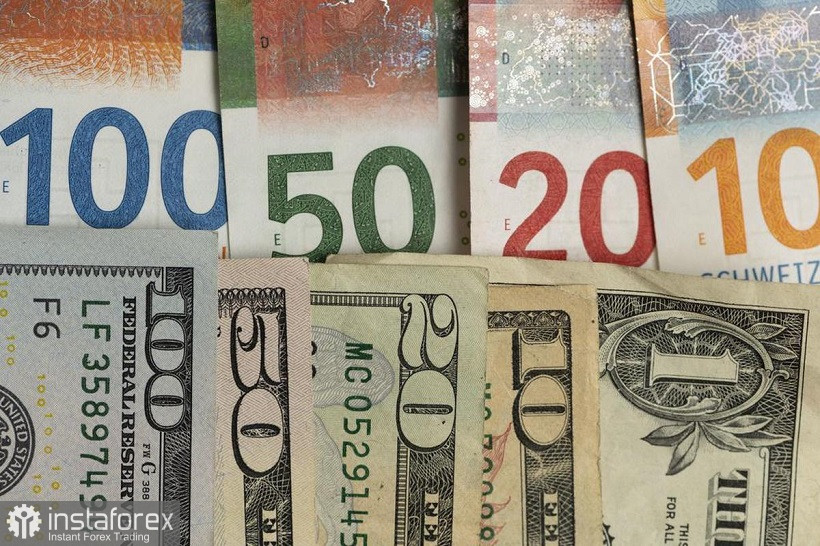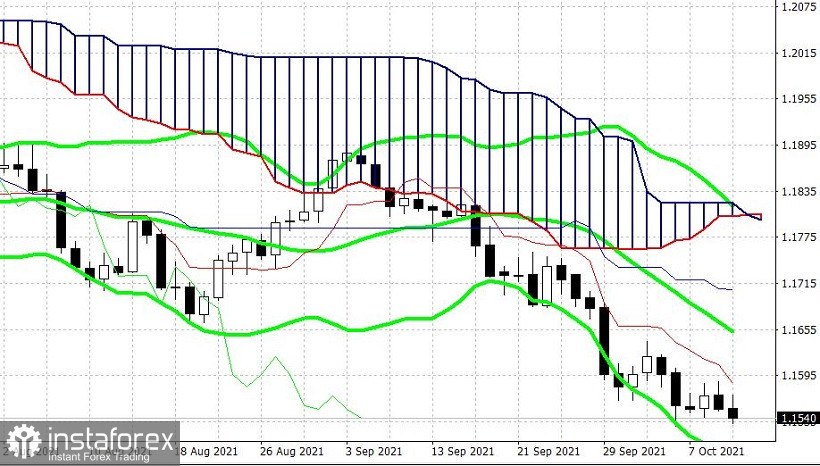The euro-dollar pair continues to be under pressure, although it is trading within a narrow price range. On the eve of tomorrow's inflation release, traders are hesitant to take active action, despite the fact that bearish sentiment clearly dominates. Indecisive attempts by EUR/USD bulls to develop corrective growth are actively "extinguished" by bears who use even minimal upward pullbacks to open short positions. Bears are taking profits in the area of the current year's price lows, also not daring to keep short positions open on the eve of tomorrow's important events.
Let me remind you that key data on the growth of inflation in the United States will be published on Wednesday, as well as the minutes of the Federal Reserve's September meeting. According to preliminary forecasts, the September CPI figures should repeat the trajectory of the August ones. The overall consumer price index should reach 0.3% (on a monthly basis), and in annual terms – rise to 5.3%. The same result was in the previous month. Core inflation should reflect an increase in monthly terms to 0.2% (the indicator increased by 0.1% in August) and an increase to 4.1% year–on-year (in August - 4.0%). If tomorrow's figures come out at least at the forecast level (not to mention the green zone), the greenback will receive additional support throughout the market, including in pairs with the euro.

So, the pressure on the euro was exerted by today's figures from the ZEW Institute. The index of sentiment in the German business environment collapsed immediately to 22 points – this is the weakest result since March 2020, when the Germans had just begun to feel the effects of the first coronavirus strike. Experts, of course, expected negative dynamics in October (taking into account the energy crisis and the pessimistic rhetoric of the European Central Bank), but, according to their forecasts, the indicator should have decreased by only two points (whereas in fact it decreased by almost 5 points). For comparison: this indicator came out at the level of 84 points in May, then it was at the level of 79 in June. This indicator showed similar dynamics in Europe as a whole. If the European ZEW index was at the level of 84 points in May, then in October it dropped immediately to 21 points. After the spring surge of optimism, when both in Germany and in the EU as a whole, indicators showed steady growth for the first time after the peak of the crisis, this dynamics looks depressing, and this fact had a corresponding impact on the single currency.
In addition, the EUR/USD pair came under pressure from the dovish rhetoric of representatives of the ECB. In particular, ECB chief economist Philip Lane said yesterday that the medium-term dynamics of inflation "is too slow." At the same time, he reiterated the theses that he voiced last week. In particular, he urged to ignore the current inflationary growth, as it is provoked mainly by temporary factors – in particular, the rise in the cost of energy. He also expressed concern that there is no comparable increase in the level of wages against the background of the growth of the consumer price index.
The dovish rhetoric was also voiced by another influential representative of the ECB - the head of the Bank of France, Francois Villeroy. The Governing Council member supported the opinion of ECB President Christine Lagarde and Philippe Lane that the growth of inflation indicators is temporary. Moreover, in his opinion, there is a risk that inflation in the second half of next year and (especially) in the first half of 2023 will be below the target level. In this context, Villeroy noted that the European economy needs and will need to maintain accommodative monetary policy. Summarizing his thought, he stressed that the curtailment of the PEPP program would not signal the end of the "era" of a soft approach.
It should be noted here that rumors have been circulating on the market for a long time that the ECB may announce or hint at an expansion of the APP program, the volume of which currently amounts to 20 billion euros per month. According to one version, the ECB will almost double this amount next spring.

Thus, the fundamental background for the euro remains negative, while the dollar froze in anticipation of tomorrow's "inflationary verdict". That is, on the one hand, the EUR/USD pair is feeling the pressure of bears, but, on the other hand, it remains within a narrow price range, trading around the price lows of the year. The support level is 1.1529 (13-month low). The pair's bears are not yet able to retest this target, let alone settle below it - this requires an informational impulse. Such an impulse could be tomorrow's inflationary release, if, of course, it does not disappoint the dollar bulls. Therefore, it is best to take a wait-and-see attitude before the data is published, since the market may emotionally react to the published numbers (i.e. there is a risk of false price movements). In general, in my opinion, the downward trend in any case will not lose its relevance due to the extremely weak positions of the single currency.





















